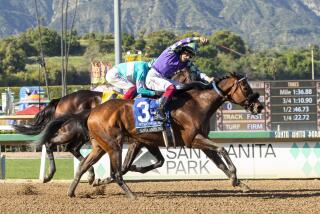More and More Refined Handicapping
- Share via
Ever since speed handicapping came into vogue a decade ago, students of racing have sought more and more refined ways to translate horses’ performances into numbers.
Traditional methods have dealt with the final time of a race. If a horse runs six furlongs in 1:11, he will earn a speed figure that depends on the condition of the race track. How he runs--whether he is a front-runner or stretch-runner--is irrelevant.
Yet this time-honored approach glosses over a lot of complexities. A horse who battles for the lead, runs the first half mile in 45 seconds and finishes in 1:11 is performing much better than a horse who coasts to the lead in :46 and hits the wire in 1:11. Could there be a mathematical way to evaluate and express the quicker horse’s superiority?
West Coast psychologist Howard Sartin and his disciples have developed a method of doing this, and it is as fascinating as it is complex. (A specially programmed, pocket-sized computer is an essential handicapping tool.)
The Sartin method evaluates a horse by analyzing his velocity--in feet per second--in different segments of a race. Consider a six-furlong race run in 1:10, after a half-mile fraction in :45 flat. A horse in this field, whom we will call Theoretical, trails by four lengths at the half-mile mark and two lengths at the finish. How fast did he run?
A traditional speed handicapper would say that he covered six furlongs in 1:10 2-5 (since a length roughly equals one-fifth of a second.) Sartin calculates his speed this way: There are 660 feet in a furlong, and 3,960 feet in six furlongs. Assuming that one length equals 10 feet, Theoretical ran 20 feet less than six furlongs in 70 seconds. Therefore his true speed is 3,940 feet divided by 70 seconds, or 56.286 feet per second. This would be written: (6x660-20) divided by 7056.286 feet per second.
This is too elementary to be of much interest to the members of the Sartin school. They are concerned with Theoretical’s rate of speed in the early and late stages of the race.
In the first half-mile, when Theoretical was four lengths behind a 45-second fraction, his Early Pace was (4x660-40) divided by 4557.778 feet per second.
In the final quarter-mile, which was run in 25 seconds, Theoretical gained two lengths on the leader, and thus ran 20 feet more than two furlongs. His Late Pace is calculated: (2x660+20) divided by 2553.60 feet per second.
We’re still at the kindergarten level of the Sartin methodology. Working with these facts about a horse’s performance, Sartin creates a variety of numbers that further define the animal’s style and capability. He adds the horse’s Early Pace and Late Pace and calls the resultant figure Total Energy. In the case of Theoretical, 57.778 feet per second for Early Pace, plus 53.60 feet per second for Late Pace, equals a Total-Energy rating of 111.378.
The 57.778 feet per second rate that Theoretical ran in the early stages of the race represents 51.9 percent of the energy that he expended; this is his Early Energy, and this number offers a whole new way to look at a horse’s style, instead of defining him vaguely as a front-runner or stretch-runner.
The Sartin handicappers concoct other numbers, called Sustained Pace and Average Pace, which give them further measurements of horses’ performances. When they handicap a race, they don’t have one figure for each horse, but several. They rank the contenders in each race in each category, and they might say, “Theoretical is No. 2 on Early Pace and Sustained Pace, and No. 1 on Late Pace.”
So who’s the best horse, the one to bet? That depends upon the track on which the race is being run. Tom Brohamer, one of Sartin’s followers, conceived the idea of analyzing all the results at a track to determine its tendencies, or what traditional handicappers would call its bias.
They know that a horse who expends 53 percent of his energy in the early part of a race has the optimal running style for Aqueduct; 52 percent would be better at Belmont Park. At a speed-favoring track such as Santa Anita, a horse with a high Early Pace rating would be preferred; a high Late Pace rating would be irrelevant.
Sartin is only one of many people today who are attempting to apply computers to handicapping. But most of the others are misguided; they are seeking a neat mathematical model, an all-encompassing formula, that will make it easy to pick winners. What sets Sartin and his group apart is their willingness to deal with all the diversity and complexity in the game.
It is hard for an outsider to judge their performance in dollars-and-cents terms, which is the only standard that ultimately counts, but there is no doubt that they are making a serious, intelligent effort to understand the mysteries of handicapping.
More to Read
Go beyond the scoreboard
Get the latest on L.A.'s teams in the daily Sports Report newsletter.
You may occasionally receive promotional content from the Los Angeles Times.









